-
Key Takeaways
-
What Is Spatial Disorientation?
-
Inversion Illusion
- How to Prevent the Inversion Illusion
-
Coriolis Illusion
- How to Prevent the Coriolis Illusion
-
Elevator Illusion
- How to Prevent the Elevator Illusion
-
False Horizon Illusion
- How to Prevent the False Horizon Illusion
-
Leans Illusion
- How to Prevent The Leans
-
Autokinesis Illusion
- How to Prevent the Autokinesis Illusion
-
Graveyard Spiral Illusion
- How to Prevent the Graveyard Spiral
-
Somatogravic Illusion
-
How to Prevent the Somatogravic Illusion
-
Conclusion
This article could save your life.
That’s a bold statement, but it’s true. Flying can mess with your senses in ways you wouldn’t expect. You might feel like you’re climbing or turning even though your instruments say otherwise.
These sensory tricks or illusions are no small issue for pilots, and they can be potentially life-threatening.
Using the acronym ICEFLAGS, you can remember the eight most common illusions: Inversion, Coriolis, Elevator, False Horizon, Leans, Autokinesis, Graveyard Spiral, and Somatogravic.
Each one can throw you off course if you’re not careful. But don’t worry, in this article, we’ll explore the eight illusions you may experience as a pilot.
By the end, you’ll know what each of these illusions feels like and how to stay in control by trusting your instruments over your instincts.
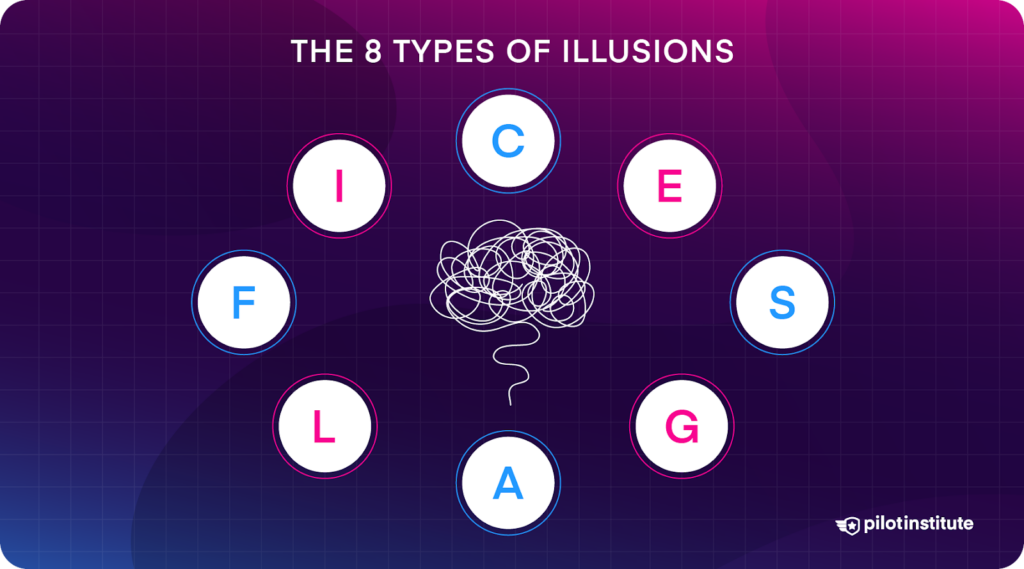
ICEFLAGS stands for:
- Inversion
- Coriolis
- Elevator
- False Horizon
- Leans
- Autokinesis
- Graveyard Spiral
- Somatogravic
Ready for an eye-opener?
Key Takeaways
- Spatial disorientation can affect a pilot’s ability to control the aircraft.
- ICEFLAGS helps pilots remember the 8 common illusions: Inversion, Coriolis, Elevator, False Horizon, Leans, Autokinesis, Graveyard Spiral, and Somatogravic.
- Trust your instruments over sensory perceptions.
- Illusions are caused by the body’s misinterpretation of motion and position.
What Is Spatial Disorientation?
Spatial disorientation is a pilot’s misunderstanding of their aircraft’s position, motion, or attitude in relation to the Earth’s surface.
For example, you feel that you’re turning when, in fact, your wings are perfectly level.
What can cause such a false perception?
Illusions.
When your body’s sensory inputs send confusing or misleading signals to your brain, your brain will misinterpret them (i.e., cause an illusion). Spatial disorientation might sound like something out of a science fiction movie, but it’s a very real part of flying.
The illusions in the ICEFLAGS acronym play a significant role in causing this disorientation.
Inversion Illusion
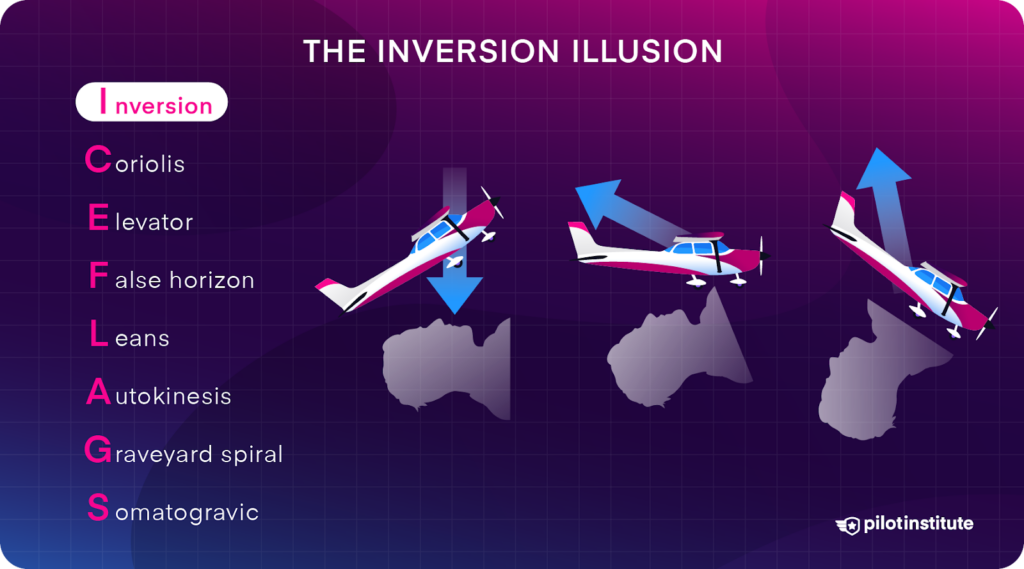
The inversion illusion happens when a pilot quickly transitions from a climb to straight-and-level. In other words, they pitch the nose down quickly, making them feel like they’re tumbling backward.
Because the pilot feels that they are tumbling backward, they may pitch the nose down even further, intensifying the illusion and leading to a dangerous low-nose attitude.
The inversion illusion results from some complex interplay between your inner ear and brain.
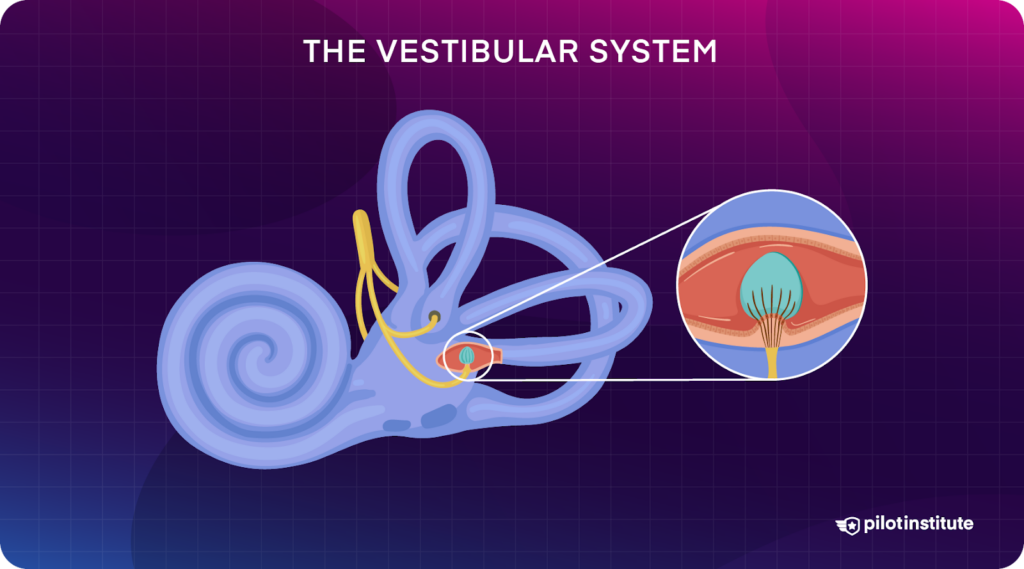
Inside your ears, there are three semicircular canals filled with fluid, which move when your head moves. These canals are at right angles to each other, and each one detects a different type of movement: up and down, side to side, and tilting from one side to the other.
During an abrupt change from climbing to level flight, the fluid in the vertical canals of your inner ear continues to move. Your brain misinterprets this as a sensation of still climbing, making you feel like you’re tumbling backward.
This false perception of your body’s position – thinking you’re in a climb when you’re not – leads to the inversion illusion. It’s your brain playing tricks on you by interpreting the signals from your inner ear incorrectly.
That’s why it’s crucial to trust your instruments over your senses – they aren’t subject to these physiological illusions!
How to Prevent the Inversion Illusion
Preventing the inversion illusion boils down to one key factor: managing your aircraft’s movements smoothly and gradually.
By transitioning more gently between different stages of flight, you can help your body better adjust to the changes in motion, reducing the chance of misinterpretation.
Coriolis Illusion
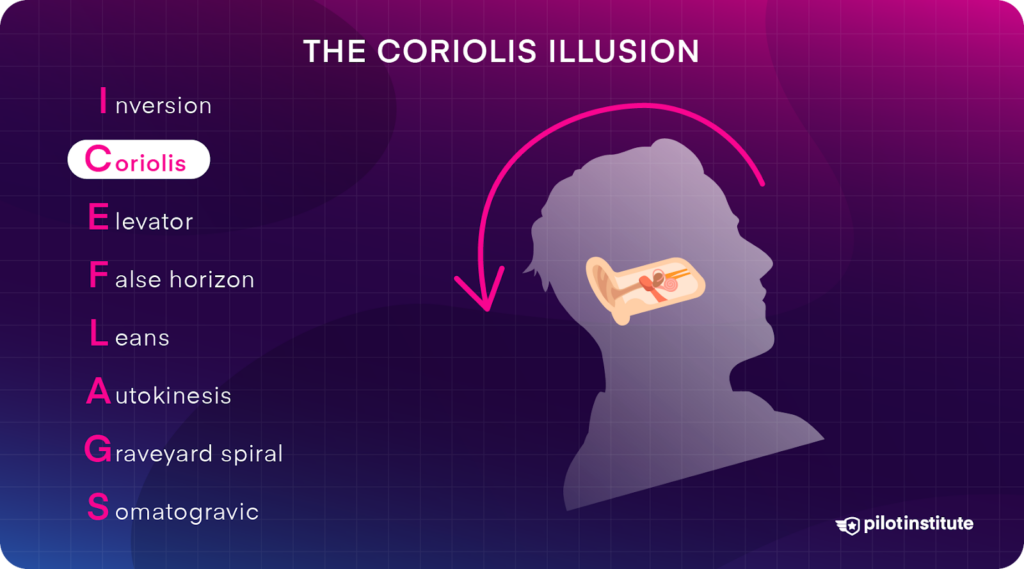
Imagine you’re turning steadily in one direction for a while (say, to the left). Your body has gotten used to this motion, but then, you suddenly move your head down to check a chart or up to look at an overhead panel.
Whoa!
Suddenly, it feels like you’re tumbling or rotating in all sorts of directions, not just the gentle left turn you initiated.
Welcome to the dizzying world of the Coriolis Illusion.
The culprit?
Those semicircular canals in your ears again.
When you’re turning for a while, the fluid in your ear canals starts to move at the same speed as the canal walls, tricking your brain into thinking you’ve stopped turning.
Then, when you move your head suddenly, the fluid moves across multiple canals, sending your brain mixed signals and causing you to feel like you’re tumbling head over heels.
How to Prevent the Coriolis Illusion
So how do you keep the Coriolis Illusion in check? Keep your head movements slow and steady during turns, particularly when flying on instruments.
Elevator Illusion
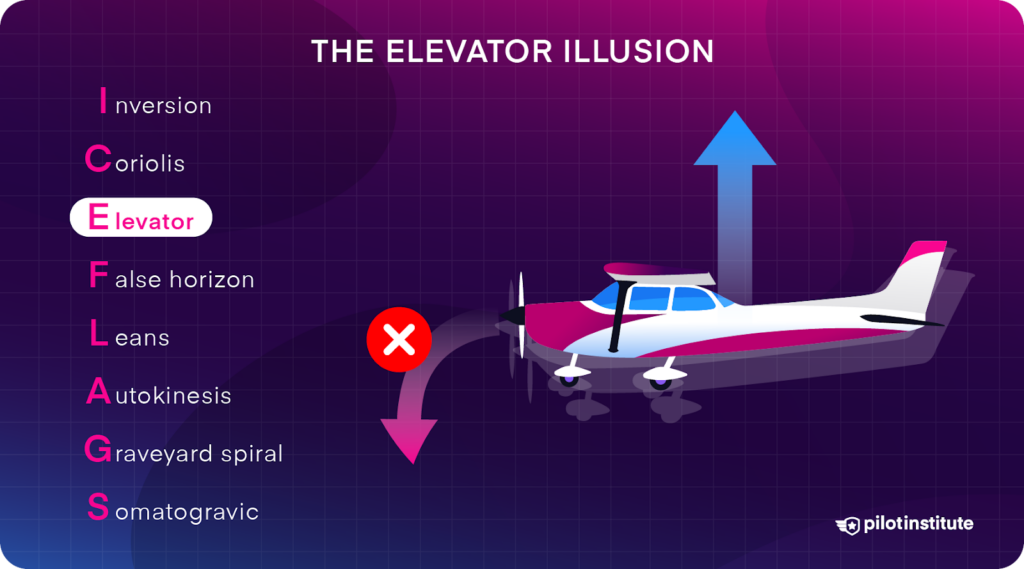
Picture this: you’re flying along in less-than-perfect visibility when suddenly, you hit an updraft.
Your aircraft gets a quick boost, and your inner ear tells your brain that you’re in a climb. However, you’re not climbing – your altitude hasn’t changed.
This false sensation can prompt you to push the aircraft’s nose down, potentially initiating a descent.
This illusion gets its name because it feels a lot like the momentary floating sensation you get when an elevator starts moving upward rapidly.
How to Prevent the Elevator Illusion
The solution to the Elevator Illusion?
Trust your instruments! They’ll give you an accurate picture of your altitude and climb rate, not your gut feeling.
Always cross-check your instrument readings before taking corrective action based on what your senses are telling you.
False Horizon Illusion
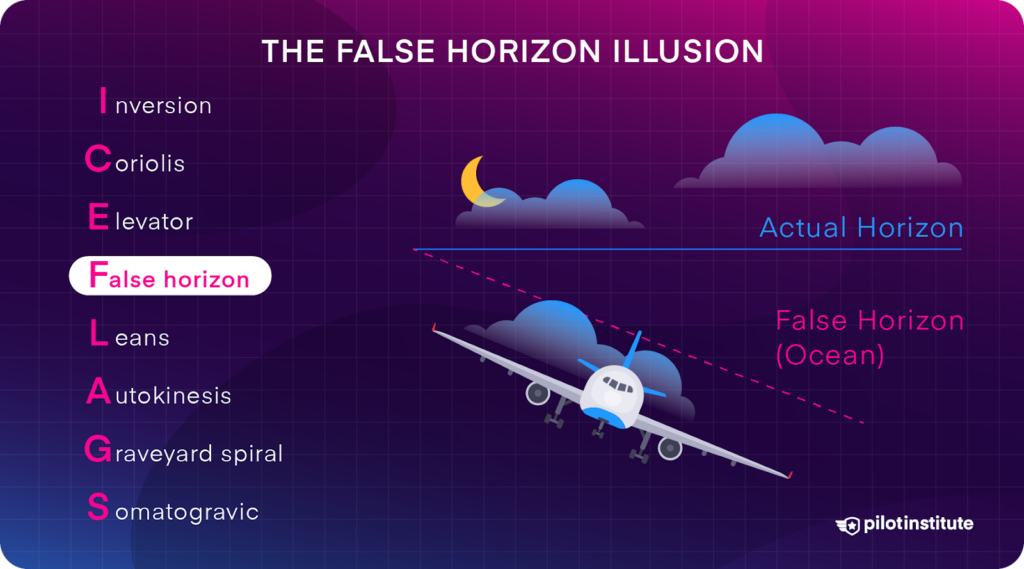
This illusion is a master of disguise and can really trip you up if you’re not careful.
Let’s set the scene.
You’re flying at night or in poor visibility conditions with no distinct horizon. There may be city lights below, stars above, or you’re over water with no discernible landmarks.
Suddenly, your brain spots something, a cloud bank, a line of lights, or a pattern of stars, and decides, “That’s the horizon!”
Spoiler alert: It’s not.
This misperception can lead to incorrect control inputs as you adjust your aircraft’s attitude based on a fictitious horizon.
How to Prevent the False Horizon Illusion
The antidote to the False Horizon Illusion? You’ve got it – rely on your instruments! They don’t care about cloud banks, city lights, or star patterns.
To further arm yourself against this illusion, enhance your understanding of your aircraft’s attitude indicator. Learn to interpret it correctly and trust it over your senses.
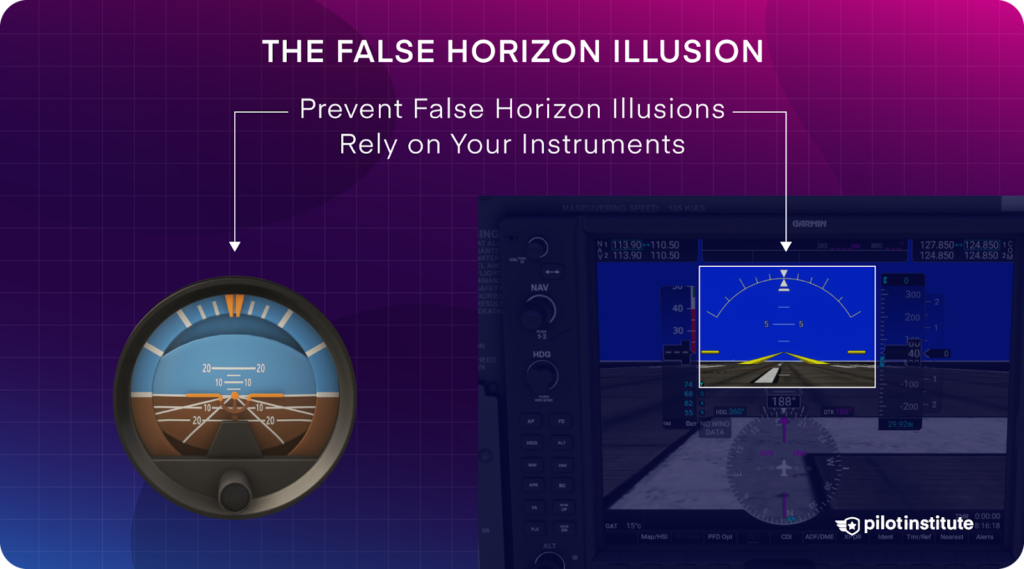
It’s all about keeping the horizon in sight – even if it’s the one on your dashboard!
Leans Illusion

This one’s a subtle trickster, so get ready.
Say you’ve unknowingly entered a slow, gentle bank. You correct the bank, but it is so gradual your inner ear doesn’t detect it.
Your senses still believe you’re straight and level, so when you level out, it feels like you’re banking in the opposite direction.
Your instinct may be to return to the original bank to ‘level’ the aircraft, thus creating a continuous banked turn.
This deceptive sensation is aptly named the Leans.
It’s called the leans because you feel like you’re leaning to one side, even though you’re perfectly level.
How to Prevent The Leans
To avoid the leans, apart from trusting your instruments, you should avoid slow, gradual turns.
You should always use smooth inputs, but try to avoid “creeping” into a turn.
Additionally, keep cross-checking your instruments to avoid inadvertently turning.
Autokinesis Illusion
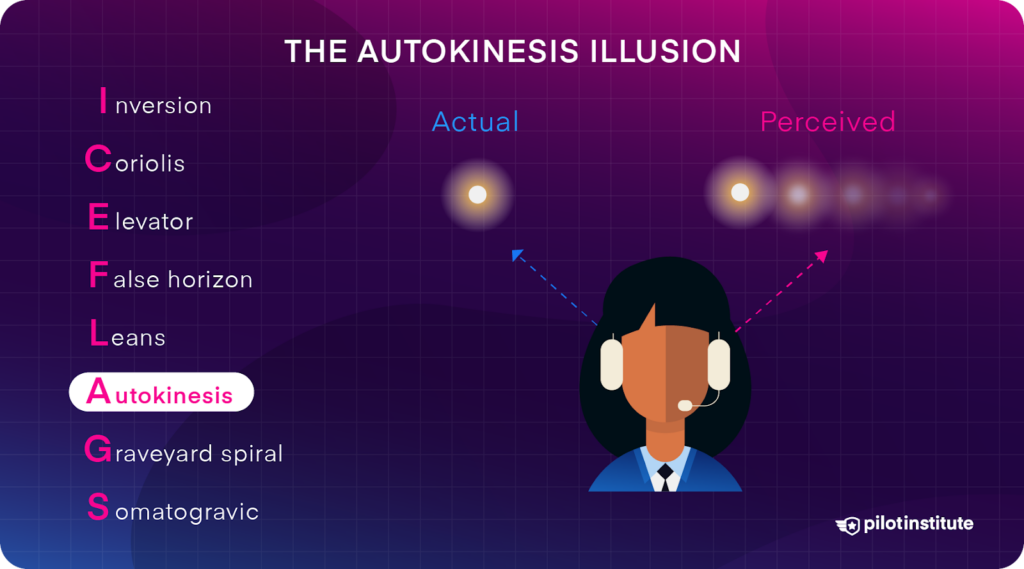
Imagine you’re flying at night, and there’s a stationary light in the distance. If you fix your gaze on this light for more than a few seconds, it can start to move – on its own!
Well, not really.
The light isn’t moving at all, but your brain insists it is. This perception of movement where there is none is the autokinesis illusion.
This illusion can lead to misjudging the movement of other aircraft at night. You might think another airplane is moving when it’s not, or you might misinterpret its speed and direction. And if you think a star or a far-off light is another aircraft, you might find yourself chasing phantoms across the night sky!
How to Prevent the Autokinesis Illusion
The countermeasure to autokinesis? Don’t stare at a single point of light for too long. Keep your eyes moving and scan different areas of the sky.
Graveyard Spiral Illusion
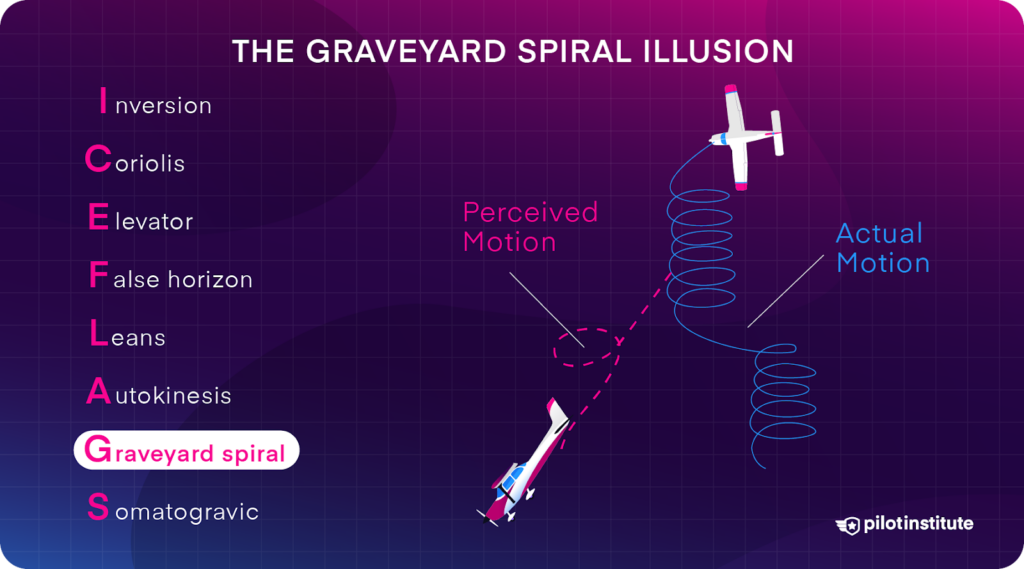
You’ve entered a gentle turn that has gone unnoticed. Because your inner ear adjusts to the turn, it stops sending turn signals to your brain.
When you finally notice and correct the turn, it feels like you’ve started turning in the opposite direction. In reaction to this false perception, you re-enter the original turn.
Here’s where things get dangerous.
As you continue this unnoticed turn, your aircraft starts to lose altitude (because the nose will drop during a turn).
If you pull back on the yoke without leveling the wings, you’ll tighten the turn and descend even faster.
This deadly descent is what we call a graveyard spiral. Out of all eight illusions, the graveyard spiral poses the greatest danger to pilots.
How to Prevent the Graveyard Spiral
Cross-checking your instruments is the best way to avoid entering the graveyard spiral.
A quick identification and correction of the bank is all you need to avoid the graveyard spiral altogether.
Somatogravic Illusion
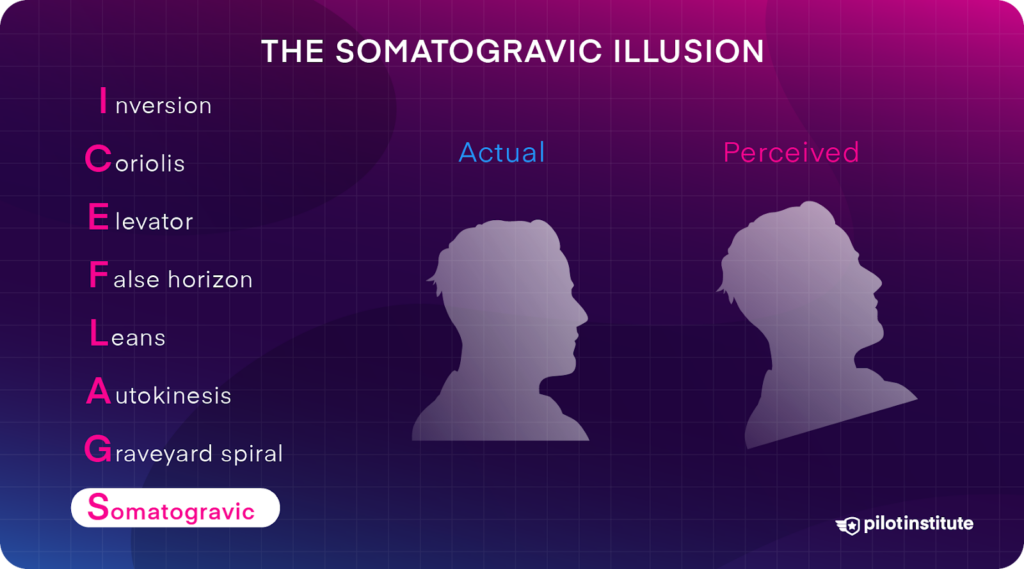
Let’s say you increase power to increase speed at night or in IMC (Instrument Meteorological Conditions).
The rapid acceleration pushes you back in your seat, giving a sensation similar to pitching up.
Your brain, ever so deceptive, interprets this feeling as a climb.
You might inadvertently push the nose down to counter this, causing a dangerous descent.
Welcome to the somatogravic illusion.
The same can happen in reverse during deceleration. The reduced forward pressure can feel like a downward pitch, potentially causing an unnecessary climb.
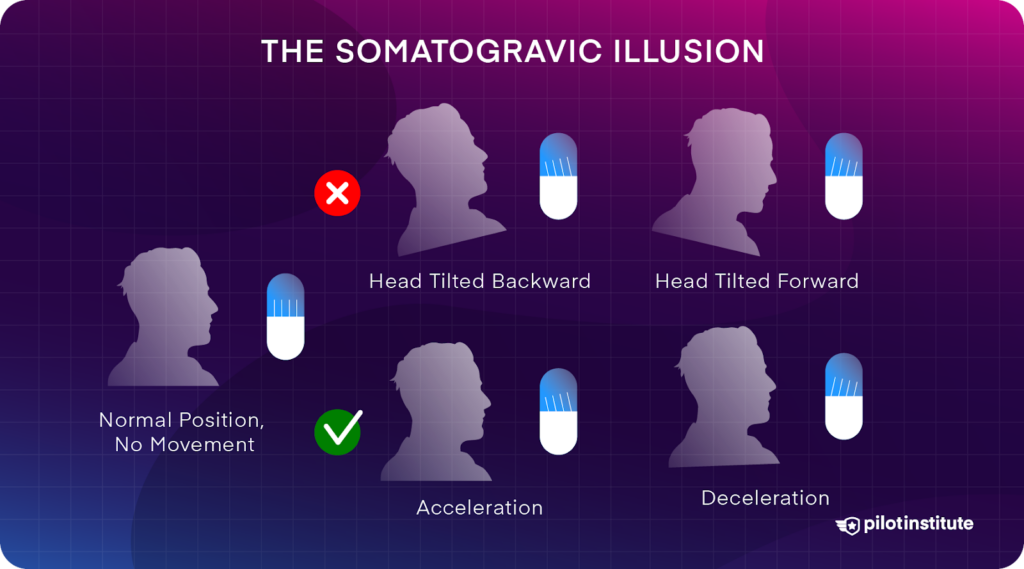
How to Prevent the Somatogravic Illusion
A good old instrument scan will go a long way in preventing the somatogravic illusion.
Additionally, try to avoid unnecessary rapid increases or decreases in airspeed.
Conclusion
Each illusion, from the inversion to the somatogravic, describes our brain’s unique interpretation of the world around us – and, more importantly, how these interpretations can sometimes lead us astray.
The knowledge of these illusions, however, is not enough. Recognizing them when they occur and knowing how to combat them are critical skills for any pilot.
And the key to doing so? Trust your instruments.



